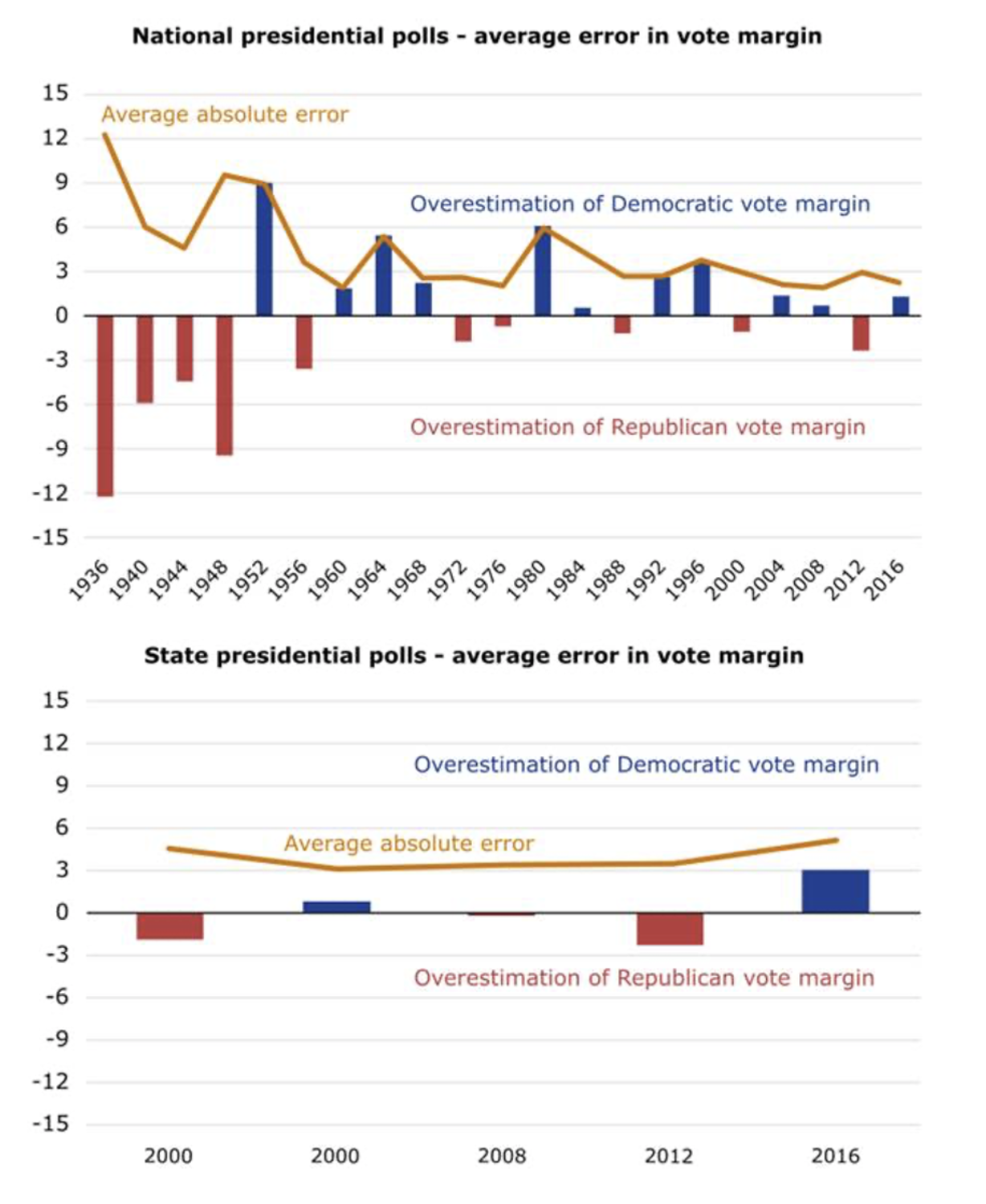Can you trust U.S. election polls in 2020?
The 2016 election result seemed to reveal a catastrophic fallacy in the US pre-election polls, triggering numerous analyzes of potential mistakes. They found that the national polls were de facto relatively adequate and correctly predicted Hillary Clinton would win the voter majority, with only a slight deviation from the poll estimates. However, the situation was different for the Pennsylvania, Michigan, and Wisconsin state polls. The average scores in these three states showed a clear advantage for Clinton. Ultimately, however, in these states Donald Trump gained a minimal advantage, which determined the result of the elections.
About the author
 Anders Nysteen - joined Saxo Bank in 2016 to the department Quantitative Strategiesand its main goal is to develop mathematical trading strategies and asset allocation models. Anders holds a degree in physics and nanotechnology from the Technical University of Denmark and a PhD in quantum photonics.
Anders Nysteen - joined Saxo Bank in 2016 to the department Quantitative Strategiesand its main goal is to develop mathematical trading strategies and asset allocation models. Anders holds a degree in physics and nanotechnology from the Technical University of Denmark and a PhD in quantum photonics.
In almost all US presidential elections, the candidate who obtains the majority of the national votes also wins the majority of the electoral votes and thus wins the election. This seemed to be the case in the days leading up to Election Day in 2016, when polls hinted at around 90% probability that Clinton would win, with a range of 71-99% probability.
Below, we analyze selected findings of such analytical centers as American Association for Public Opinion Research (AAPOR) or Marist College's Institute for Public Opinion on the reasons for the underestimation of support for Trump by state polls.
Undecided voters played an important role
In key states, more than half of undecided voters voted for Trump. In Pennsylvania, Michigan, Wisconsin and Florida, 11-15% of voters only made a decision in the last week before the election. At the national level, 20% of voters in 2016, three months before the elections, had not taken any decisions. This time the situation is slightly different. Three months before the 2020 elections, only 10% of respondents declared that they were still undecided (or did not care about it), however, according to analysts, this percentage is still large enough to affect the election result.
Undecided voters are largely influenced by specific events, and research has shown that negative campaigns and election announcements can have a greater impact on undecided voters than positive campaigns. Will Biden's significant spending on the negative campaign and Trump's recent tax problems tip the balance in favor of Biden, or will Trump make a strong finish due to Biden's unfavorable stance during the debate? The election cycles to date have shown that significant changes may take place in the last weeks of the campaign, despite the fact that the polls show much greater stability in the current cycle.
Correction for education
This adjustment has been made in many national surveys, but few in the state surveys. Voters with higher education take part in polls more often than people with lower education. In a 2017 study analyzing typical national surveys, 45% of respondents had a bachelor's degree or higher, although only 30% of Americans had a bachelor's degree.
During both Obama campaigns, white voters with lower education began to lean towards the Republican Party. In addition, lower educated voters tend not to follow the news continuously, making them more susceptible to persuasion - particularly through targeted social media, which may have had a decisive influence on voters in undecided states in 2016. Polls in key states during the elections in 2016 may have had too many voters with a university education, which was associated with overstated support for Clinton.
Geographic distribution
Geographic distribution plays a large role in selecting representative polls because specific groups of voters may vote differently depending on whether they live in urban, suburban or rural areas. As a result, an uneducated white male living in the countryside may have quite different political views from an uneducated white male living in a major city or suburb in the same state.
Change in attendance in relation to key demographic groups
This was another key factor in the 2016 elections compared to the patterns observed in 2012. In some key states, turnout among Republican supporters and rural voters increased, while in some key Democratic voter groups - especially black Americans - it decreased. Clinton's strong lead in the polls may have lowered the vigilance of some Democratic Party voters, who may have felt that their vote would not influence the election results.
Trump's silent voters
In 2016, the number of Trump supporters who did not want to reveal their actual preferences in pre-election polls may have exceeded the number of last-minute people declaring their willingness to vote for Clinton, even though no definite clear effects were shown. A recent study CloudResearch points out that for the 2020 election, Trump supporters are half as likely to reveal their true voting preferences compared to Biden's voters.
2020 survey revision
Opinion polling centers conduct research in different ways and through different media, and therefore they may be biased towards certain groups of voters. For example, 10% of American adults do not use the Internet - in the online survey, this group - stereotypically described as people aged 65+ without higher education and low income, living in rural areas - will not be sufficiently represented. A perfectly objective poll will never be possible, but being aware of this kind of bias can help research centers adjust their results for overrepresentation.
Over time, especially thanks to the Internet, barriers to conducting polls have been significantly lowered and the electoral landscape is often distorted by low-quality polls. Many polls repeat errors in similar states, resulting in systematic inaccuracy, and the correlation between poll results can easily be underestimated.
The margin of error is typically ± 3% for state polls, which only cover a small subset of the general population. Recent research showed that when estimating other possible errors, such as the correlation between state poll errors, the real margin of error should be twice as large. In practice, this means that some 2016 state surveys would not be able to identify a winner within the survey's uncertainty limits.
Larger polling centers seem better prepared for the 2020 elections and are trying to learn from the mistakes made in 2016. Many of these mistakes could have been avoided by conducting more comprehensive polls. However, there is a risk that, as a result, we will receive surveys trying to over-adjust to the 2016 scenario, which will miss many new aspects specific to 2020. One of such challenges is the Covid-19 pandemic, which may affect some group of voters more than others, and may even contribute to lowering the overall turnout.
When analyzing the 2020 election polls, it is therefore necessary to take into account i) methods of selecting the surveyed group, ii) whether the survey revealed other parameters, such as education or place of residence, and iii) whether the results of the poll also include the scope of uncertainty. The above issues seem to be the minimum requirements for conducting a meaningful election poll in 2020, and in the event that these aspects are not specified, particular care should be taken when formulating definitive conclusions.
The average margin of error of the national polls (first graph) shows a downward trend and was relatively low during the 2016 elections. However, the average margin of error of the state polls (second chart) was greater in 2016 than for the four previous presidential elections. The charts are based on AAPOR data.























![Forex Club – Tax 9 – Settle tax on a foreign broker [Download the Application] Forex Club - Tax 9](https://forexclub.pl/wp-content/uploads/2024/02/Forex-Club-Podatek-9-184x120.jpg?v=1709046278)
![Trading View platform – solutions tailored to the needs of traders [Review] trading view review](https://forexclub.pl/wp-content/uploads/2024/03/trading-view-recenzja-184x120.jpg?v=1709558918)
![How to connect your FP Markets account to the Trading View platform [Guide] fp markets trading view](https://forexclub.pl/wp-content/uploads/2024/02/fp-markets-trading-view-184x120.jpg?v=1708677291)
![How to invest in ChatGPT and AI? Stocks and ETFs [Guide] how to invest in chatgpt and artificial intelligence](https://forexclub.pl/wp-content/uploads/2023/02/jak-inwestowac-w-chatgpt-i-sztuczna-inteligencje-184x120.jpg?v=1676364263)


![WeWork – the anatomy of the collapse of a company valued at $47 billion [WeWork, part II] wework bankruptcy story](https://forexclub.pl/wp-content/uploads/2024/04/wework-bankructwo-historia-184x120.jpg?v=1711729561)
![Adam Neumann – the man who screwed up Softbank [WeWork, part AND] adam neumann wework](https://forexclub.pl/wp-content/uploads/2024/04/adam-neumann-wework-184x120.jpg?v=1711728724)





![How to transfer shares to another brokerage office [Procedure description] how to transfer shares to another brokerage house](https://forexclub.pl/wp-content/uploads/2024/03/jak-przeniesc-akcje-do-innego-biura-maklerskiego-184x120.jpg?v=1709556924)

![The most common mistakes of a beginner trader - Mr Yogi [VIDEO] Scalping - The most common mistakes of a beginner trader - VIDEO](https://forexclub.pl/wp-content/uploads/2024/03/Scalping-Najczestsze-bledy-poczatkujacego-tradera-VIDEO-184x120.jpg?v=1711601376)
![Learning patience: No position is also a position - Mr Yogi [VIDEO] Scalping - Learning patience - No position is also a position - VIDEO](https://forexclub.pl/wp-content/uploads/2024/03/Scalping-Nauka-cierpliwosci-Brak-pozycji-to-tez-pozycja-VIDEO-184x120.jpg?v=1710999249)
![When to exit a position and how to minimize losses - Mr Yogi [VIDEO] Scalping - When to exit a position and how to minimize losses - VIDEO](https://forexclub.pl/wp-content/uploads/2024/03/Scalping-Kiedy-wyjsc-z-pozycji-i-jak-minimalizowac-straty-VIDEO-184x120.jpg?v=1710336731)




![Who will win the US elections? [Video comment] Who will win the US elections](https://forexclub.pl/wp-content/uploads/2020/10/Kto-wygra-wybory-w-USA-300x200.jpg?v=1603704365)













